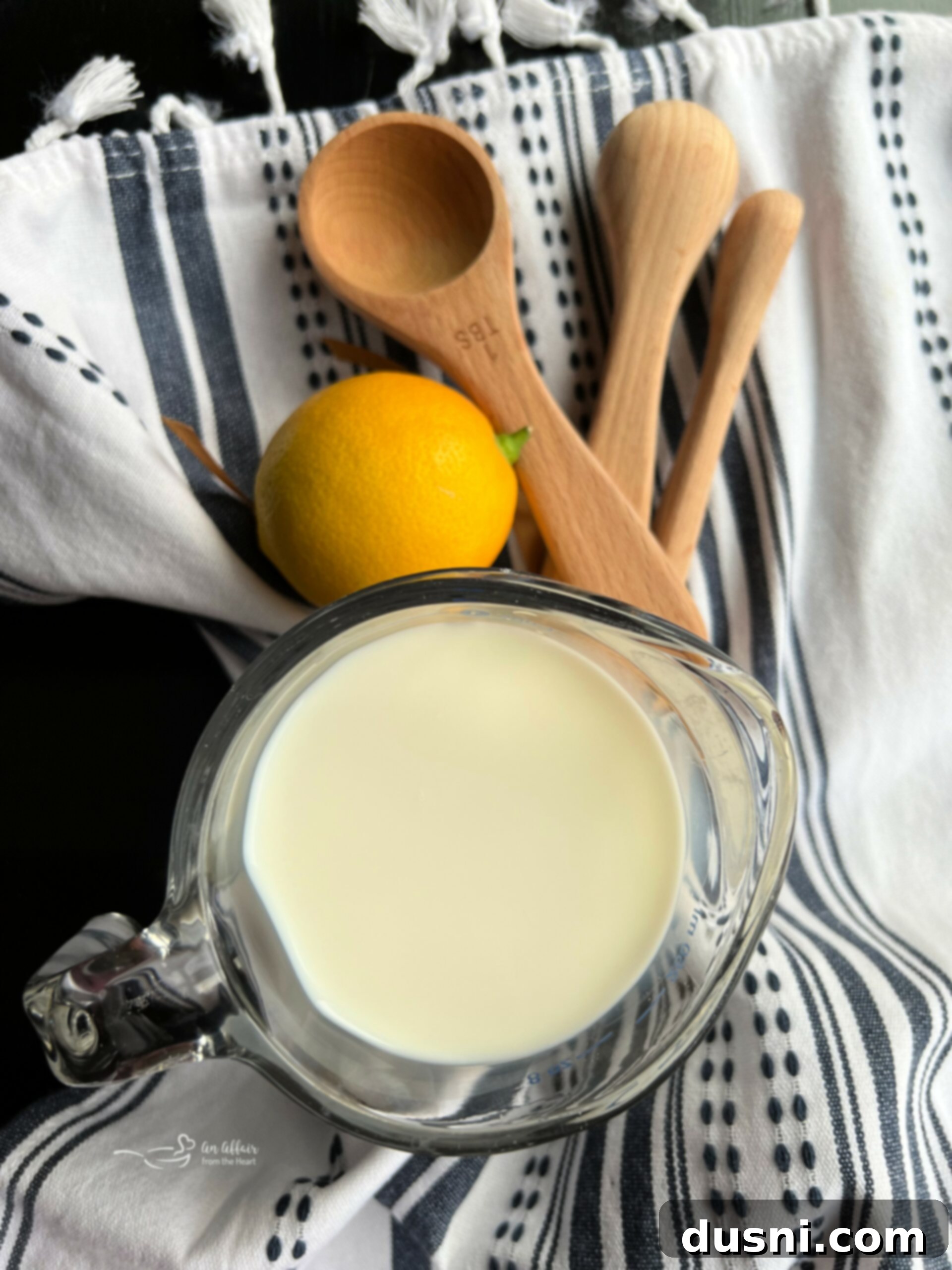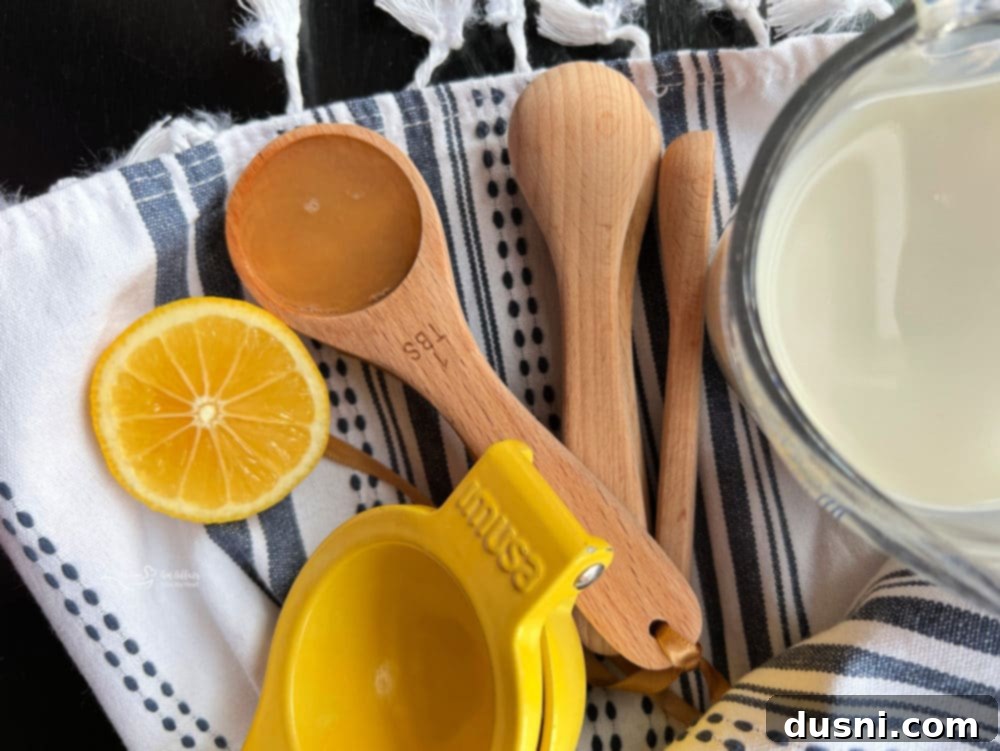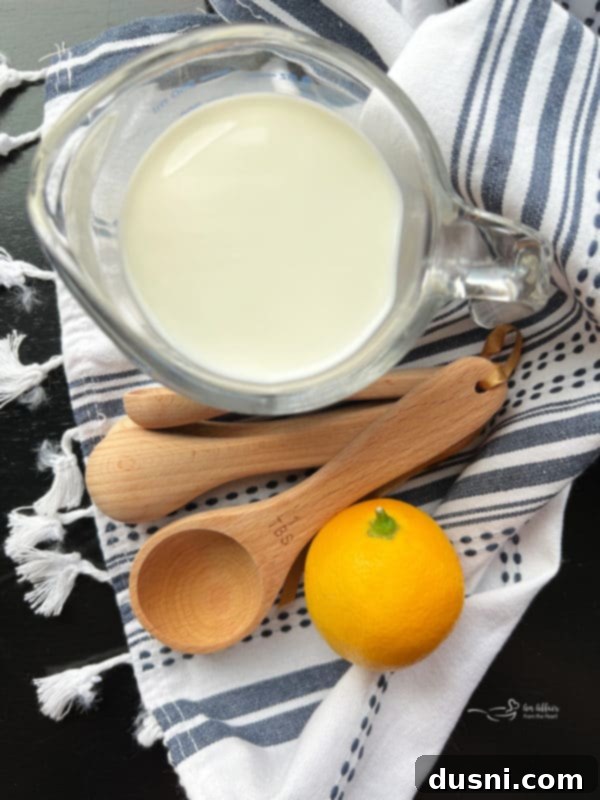How to Make Buttermilk Substitute in 10 Minutes: A Kitchen Essential
Do you ever find yourself halfway through a recipe only to realize you don’t have buttermilk? It’s a common kitchen dilemma! For years, I faced the same problem, constantly running out of or forgetting to buy buttermilk. That’s why I perfected my own simple and reliable buttermilk substitute recipe. These days, I don’t even bother buying buttermilk from the store because making it at home is incredibly easy. All you need are two basic ingredients – milk and either lemon juice or white vinegar – and just about 10 minutes of your time. This quick kitchen hack will save you a trip to the grocery store and ensure your baked goods and savory dishes turn out perfectly every time!
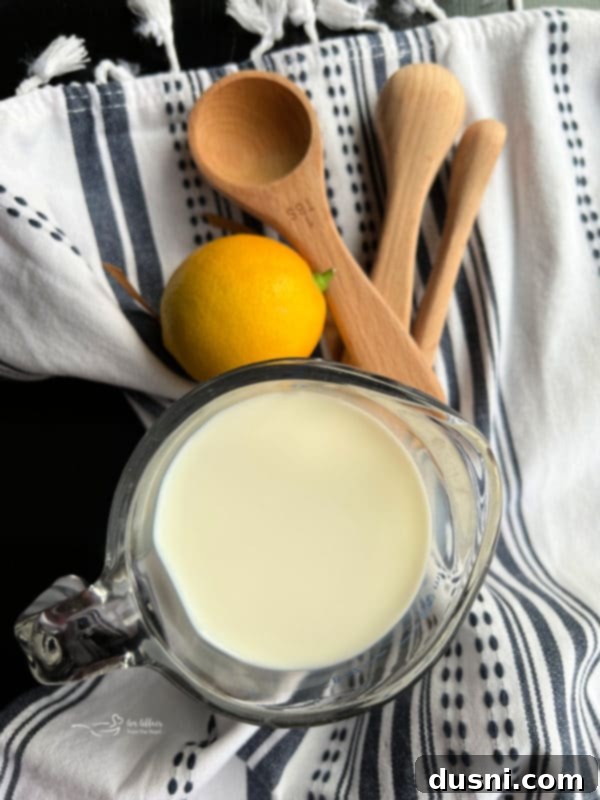
It used to be that encountering “buttermilk” in a recipe’s ingredient list would stop me dead in my tracks. My immediate thought was, “Well, time to find a new recipe, because I definitely don’t have any buttermilk on hand!” This common frustration often led to abandoning delicious ideas or making an unplanned grocery run. However, about a decade ago, I discovered a game-changing secret: you can easily create a buttermilk substitute from regular milk right in your own kitchen. This simple trick transformed my cooking and baking, making me more confident and prepared for any recipe.
Now, when I’m craving that irresistible tangy coffee cake, preparing to bread some crispy chicken, or planning to make some authentic homemade Indian fry bread, I don’t even break a sweat. The absence of store-bought buttermilk is no longer a hindrance. Instead, I simply whip up a quick and effective buttermilk replacement just before I begin cooking. This homemade alternative works wonderfully in all these recipes and more, providing the necessary acidity and flavor that buttermilk brings. It’s truly a testament to how simple yet impactful a small kitchen hack can be.
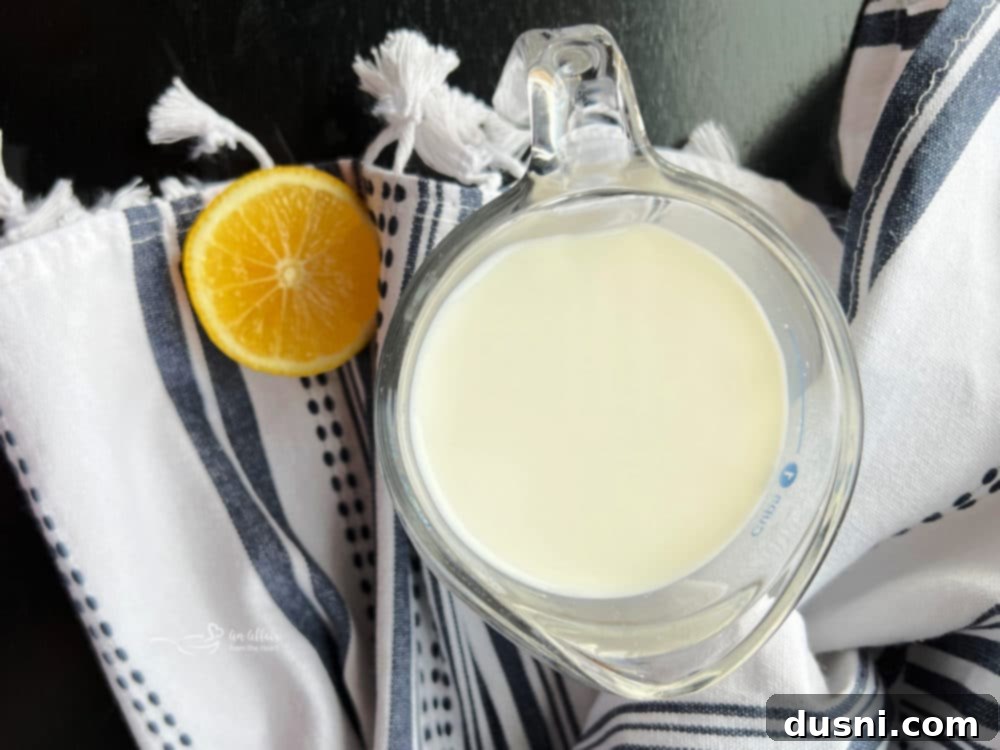
What is a Buttermilk Substitution and Why Does it Matter?
A buttermilk substitute is essentially a DIY version of fermented milk. You create it by adding an acid, such as lemon juice or white vinegar, to regular milk. The acid causes the milk proteins to curdle and thicken slightly, mimicking the texture and tangy flavor of traditional buttermilk. This quick chemical reaction is what allows you to bypass a trip to the grocery store. In just about ten minutes, you’ll have a ready-to-use ingredient that can be used interchangeably with store-bought buttermilk in most recipes. The tanginess and acidity are crucial for activating leavening agents like baking soda, contributing to light, fluffy baked goods, and adding depth of flavor to various dishes.
Understanding Buttermilk: Traditional vs. Cultured vs. Homemade
To truly appreciate a buttermilk substitute, it’s helpful to understand what buttermilk actually is. Traditionally, buttermilk was the slightly sour, thin liquid left over after churning butter from cultured cream. This “true” buttermilk was tangy due to the naturally occurring lactic acid bacteria present in the cream. However, the buttermilk you typically buy in the dairy aisle today is what’s known as “cultured buttermilk.” This product is made by adding lactic acid bacteria cultures to pasteurized milk (usually low-fat or skim milk), which then ferments, thickening the milk and giving it its characteristic tart flavor. Our homemade buttermilk substitute works on a similar principle: we introduce an acid (lemon juice or vinegar) to regular milk, causing it to coagulate and develop that desired tangy profile, making it an excellent functional stand-in for cultured buttermilk in almost any recipe. While it won’t have the exact same bacterial cultures, its acidity and texture provide the same crucial benefits to your cooking and baking.
How to Make a Buttermilk Substitution: Simple Steps
Making your own buttermilk substitute is incredibly straightforward. My go-to choice is usually a fresh lemon if I have one available, as it imparts a lovely subtle citrus note. If not, bottled real lemon juice from the fridge works just as well. However, don’t fret if you’re out of lemons; white vinegar is an equally effective acid for whipping up this essential ingredient, especially when you’re baking and the flavor difference is negligible. The key is the acid, which initiates the curdling process.
The method is simple:
- Measure out one scant cup of milk into a liquid measuring cup or a small bowl.
- Add one tablespoon of either fresh lemon juice or white vinegar to the milk.
- Stir gently to combine the acid and milk.
- Let the mixture stand undisturbed for about 5 to 10 minutes at room temperature.
You’ll know it’s working when you start to see the milk thicken slightly and tiny curds begin to form. It won’t become as thick as yogurt, but it will be visibly changed from its original liquid state. This visible curdling is your signal that your homemade buttermilk substitute is ready to be used in your recipe. I promise, you’ll be amazed at how simple and effective this kitchen hack truly is!
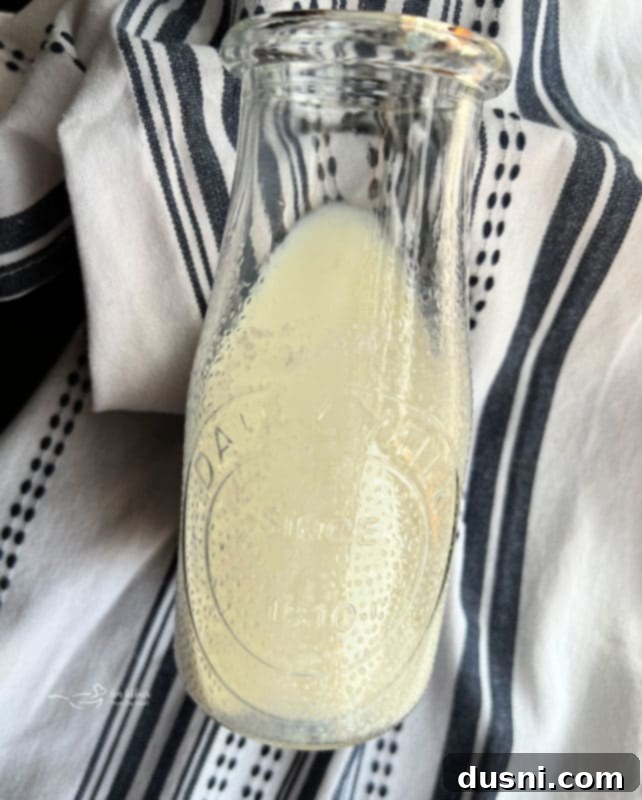
What Kind of Milk to Use for a Buttermilk Substitution?
The beauty of this buttermilk substitute recipe is its versatility when it comes to milk. You can genuinely use whatever type of milk you happen to have on hand, as the primary goal is to achieve that distinctive tanginess and acidity that buttermilk provides. Whether you have whole milk, 2% fat, 1% fat, or even skim milk, they will all work effectively. The fat content might slightly alter the richness of your final dish, but the curdling process will still occur.
For those with specific dietary needs, this method is also incredibly flexible. If you’re looking to reduce calories, feel free to use skim milk. Furthermore, if you require a non-dairy or vegan buttermilk alternative, many plant-based milks can be used! Almond milk, soy milk, oat milk, or cashew milk can all be curdled with lemon juice or vinegar to create a dairy-free buttermilk substitute. Just ensure your chosen plant-based milk is unflavored and unsweetened for the best results in savory and sweet recipes alike. This adaptability makes homemade buttermilk a universal kitchen solution.
How Do You Use Homemade Buttermilk Substitution in Recipes?
Once your homemade buttermilk substitute has formed its characteristic curds and thickened slightly, it’s ready to be used immediately. The fantastic news is that you use this homemade version in the exact same proportions as any recipe that calls for store-bought buttermilk. If a recipe asks for 1 cup of buttermilk, you simply use 1 cup of your freshly made buttermilk alternative. This particular buttermilk substitute recipe is designed to yield 1 scant cup, which is roughly equivalent to a standard cup. If your recipe requires less, you can easily cut the ingredients proportionally. For instance, for ½ cup of buttermilk, use ½ scant cup of milk and ½ tablespoon of acid. If you need more, just double or triple the recipe accordingly. The concept is straightforward: whatever amount of buttermilk your recipe specifies, make that same amount using this simple substitution method. There’s no complex math or adjustments needed, making it a truly hassle-free kitchen hack.
Can I Store My Homemade Buttermilk Substitute?
While making your own buttermilk substitute is incredibly convenient, it’s not something you should prepare in advance for long-term storage. The acidic reaction that creates the curds continues over time. If you store your homemade buttermilk substitute, especially in the refrigerator, it will continue to curdle and thicken significantly, transforming into something far more akin to fresh ricotta cheese or a very thick, lumpy curd. While this might be interesting for a different culinary purpose, it won’t function as intended in recipes that call for fluid buttermilk.
Therefore, the best practice is to make only as much as you need for your current recipe. This ensures you’re always working with a fresh, appropriately textured substitute. Unless, of course, you’re intentionally trying to make homemade ricotta from leftover milk and lemon juice – in that case, by all means, let it continue to curdle! For standard buttermilk needs, however, prepare it fresh and use it right away for optimal results in your baking and cooking.
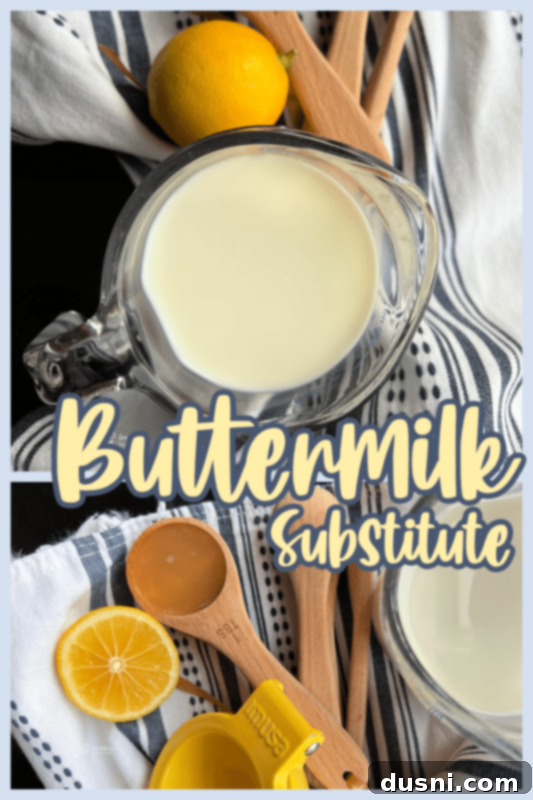
Love It? Pin It! Share This Essential Kitchen Hack!
Found this homemade buttermilk substitute tip super useful? Don’t let yourself forget where you discovered this handy kitchen hack! Make sure to Pin it to your favorite Pinterest recipe board. This way, the next time you’re in the middle of a recipe and realize you need a quick and easy substitution for buttermilk, you can find it instantly. Sharing is caring, so feel free to spread the word about this simple solution that saves time and avoids last-minute trips to the store!
What Recipes Can I Use Buttermilk Substitute In?
Buttermilk is a truly versatile ingredient that imparts a unique tangy flavor and tender texture to a wide array of recipes. Its acidity reacts with baking soda to create a light and fluffy rise, making it an essential component in many baked goods. It’s often the “secret” ingredient that elevates the taste and texture of classics like pancakes and fluffy biscuits. But its utility extends far beyond just breakfast and bread! Buttermilk is also fantastic in savory applications, marinades, and dressings, adding a layer of complexity and moistness.
Here are some of my personal favorite recipes where this easy homemade buttermilk substitute truly shines:
- Homemade Onion Strings (pictured above) – The buttermilk helps tenderize the onions and creates a perfect coating for frying.
- Corndog Mini Muffins – For a moist and flavorful batter that’s sure to be a hit.
- Spicy Baked Chicken Tenders – Buttermilk marinades are fantastic for tenderizing chicken and adding flavor before baking.
- Cranberry Orange Muffins – For a supremely tender crumb and a delightful tangy counterpoint to the fruit.
- Irish Soda Bread – A traditional staple where buttermilk is absolutely essential for texture and taste.
- Lemon Rhubarb Bundt Cake – Buttermilk keeps this cake incredibly moist and adds a lovely depth of flavor that complements the lemon and rhubarb beautifully.
From fluffy pancakes to crispy fried chicken, from tender muffins to savory dressings, the opportunities to use buttermilk (or its substitute!) are endless. Having this simple substitute recipe in your arsenal means you’ll never have to pass up a buttermilk-calling recipe again.
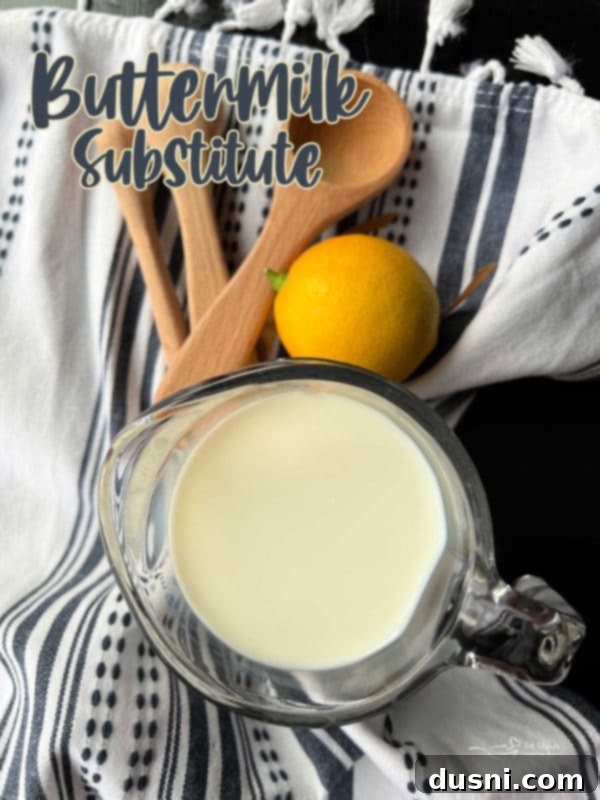
Now that you know the secret, let’s whip up some buttermilk substitute and get cooking! 
LIKE THIS RECIPE?
Don’t forget to give it a ⭐️⭐️⭐️⭐️⭐️ star rating and
leave a comment below the recipe!
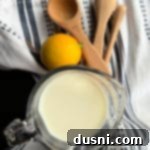
Print Recipe
Buttermilk Substitution
Equipment
-
Zyliss Comfort Utility Knife
-
Manual Juicer Citrus / Lemon Squeezer
Ingredients
- 1 scant cup of milk (any type, including non-dairy)
- 1 Tablespoon of either fresh lemon juice OR white vinegar
Instructions
-
Pour 1 Tablespoon of vinegar OR lemon juice into one scant cup of milk in a measuring cup or small bowl.
-
Gently stir the mixture to combine. Let it stand at room temperature for 5-10 minutes. The milk will begin to visibly curdle and thicken. Once you see the small curds, it’s ready!
Notes
Nutrition
This recipe was originally posted on February 22, 2015. It has been updated to improve user experience, expand content, enhance SEO, and was reshared on February 17, 2022. It may receive further updates to keep it fresh and relevant.
